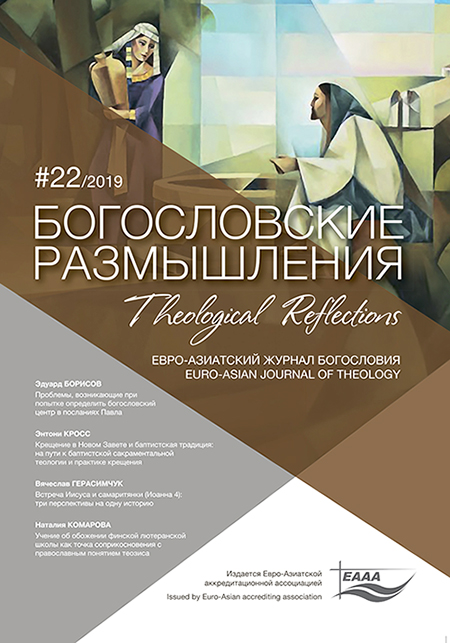Jesus and the Samaritan Woman at the Well (John 4): Three Perspectives On One Story
DOI:
https://doi.org/10.29357/2521-179X.2019.23.3Keywords:
Jesus, Samaritan woman, reader-response criticism, feminist perspective, historical-critical approach.Abstract
In his article, the author discusses some of the most significant contributions to the understanding of the encounter between Jesus and the Samaritan woman at the well (John 4) in the light of three different perspectives, viz.: readerresponse criticism, feminist analysis and historical-critical approach. Special attention is paid, in particular, to the “confessional” aspect of the woman’s response to Jesus’ testimony concerning Himself.References
- Aichele, George. 2003. “Electronic Culture and the Future of the Canon of Scripture or: The Hyperreal Bible”. In Redirected Travel: Alternative Journeys and Places in Biblical Studies. Ed. Roland Boer and Edgar W. Conrad. London: T&T Clark, 8-23.
- Black, C. Clifton. 1995. “Rhetorical Criticism”. In Hearing the New Testament: Strategies for Interpretation. Ed. Joel B. Green. Grand Rapids: Eerdmans, 256-277.
- Boers, Hendrikus. 1980. “Discourse Structure and Macro-Structure in the Interpretation of the texts: John 4:1-42 as an Example”. Society of Biblical Literature Seminar Papers 19: 159-182
- Botha, J. Eugene. 1991. Jesus and the Samaritan Woman: A Speech Act Reading. Supplements to Novum Testamentum 65. Leiden: E.J. Brill.
- Bowman, 1958. “Samaritan Studies”. Bulletin of the John Rylands Library 40/2: 298-329.
- Carson, D. A. 1991. The Gospel According to John. Leicester: Inter-Varsity Press
- Culpepper, Alan R. 1998. The Gospel and Letters of John. Nashville: Abingdon Press.
- O’Day, Gail R. 1986. “Narrative Mode and Theological Claim: a Study in the Fourth Gospel”. Journal of Biblical Literature 105/4: 657-668.
- Dockery, David S. 1988. “Reading John 4:1-45: Some Diverse Hermeneutical Perspectives”. Criswell Theological Review 3/1:127-140.
- Dube, Musa W. 1996. “Reading for Decolonization (John 4: 1-42)”. Semeia 75: 37-59.
- Eslinger, Lyle 1993. “The Wooing of the Woman at the Well: Jesus, the Reader and Reader-Response Criticism”. In The Gospel of John as Literature. Ed. Mark W.G. Stibbe. Leiden: E.J. Brill, 165-182.
- The First Apology of Justin LIII. 1979. In The Ante-Nicene Fathers. Vol 1. Ed. Alexander Roberts and James Donaldson. Grand Rapids, Mich.: Wm. B. Eerdmans Publishing Company.
- Fish, Stanley. 1980. Is There a Text in This Class?: The Authority of Interpretative Communities. Cambridge, Massachusetts: Harvard University Press.
- de Jonge, M. 1973. “Jewish Expectations about the Messiah According to the Fourth Gospel”. New Testament Studies 19/3: 246-270.
- Kim, Jean K. 1997. “A Korean Feminist Reading of John 4:1-42”. Semeia 78: 109-119.
- Memar Marqah (The Teaching of Marqah). 1963. Ed. and trans. by John Macdonald. Beihefte zur Zeitschrift für die Alttestamentliche Wissenschaft 84. Vol. 2. Berlin: W. de Gruyter.
- Moloney, Francis J. 1998. The Gospel of John. Sacra Pagina Series 4. Collegeville: The Liturgical Press.
- Moore, 1989. Literary Criticism and the Gospels. New Haven: Yale University Press.
- Neyrey, Jerome H. 2003. “What’s Wrong with this Picture? John 4, Cultural Stereotypes of Women, and Public and Private Space”. In A Feminist Companion to John. Ed. Amy-Jill Levine. Vol. 1. London: Sheffield Academic Press, 98-125.
- Okure, Teresa. 1988. The Johannine Approach to Mission. Wissenschaftliche Untersuchungen zum Neuen Testament 2:31. Tübingen: J.C.B. Mohr (Paul Siebeck.
- Phillips, Gary A. 1994. “The Ethics of Reading Deconstructively, or Speaking Face to Face: The Samaritan Woman Meets Derrida at the Well”. In The New Literary Criticism and the New Testament. Ed. Elizabeth S. Malbon and Edgar V. McKnight. Journal for the Study of the New Testament Supplement Series 109. Sheffield: Sheffield Academic Press, 283-325.
- Reinhartz, Adele. 1994. “The Gospel of John”. In Searching the Scriptures. Ed. Elisabeth Schüssler Fiorenza. Vol. 2. New York: Crossroad, 561-600.
- Sargent, Benjamin. 2016. Written for Our Learning: The Single Meaning of Scripture in Christian Theology. Eugene, Oregon: Cascade.
- Schneiders, Sandra M. 1997. “A Case Study: A Feminist Interpretation of John 4:1-42”. In The Interpretation of John. Ed. John Ashton. Edinburgh: T.&T. Clark, 235-259.
- Schneiders, Sandra M. 1993. “Women in the Fourth Gospel and the Role of Women in the Contemporary Church”. In The Gospel of John as Literature. Ed. Mark W.G. Stibbe. Leiden: E.J. Brill, 123-144.
- Schottroff, Luise. 1996. “Important Aspects of the Gospel for the Future”. In “What is John?” Readers and Readings of the Fourth Gospel. Ed. Gail. R. O’Day. Atlanta: Scholars Press, 1996, 205-210.
- Тисельтон, Э. 2011. Герменевтика. Черкассы: Коллоквиум.
- Thomson. J.E.H. 1919. The Samaritans. Their Testimony to the Religion of Israel. Edinburgh: Oliver and Boyd.
- van Unnik, W.C. 1979. “A Greek Characteristic of Prophecy in the Fourth Gospel”. In Text and Interpretation: Studies in the New Testament. Ed. Ernest Best and R. McL.
- Wilson. Cambridge: Cambridge University Press, 211-229.
- Vanhoozer, K. J., 1995. “The Reader in New Testament Interpretation”. In Hearing the New Testament: Strategies for Interpretation. Ed. Joel B. Green. Grand Rapids, Mich.: Wm. B. Eerdmans Publishing Company, 301-328.
- Victor, Royce М. 2016. “Jesus and the Samaritan Woman: Liberation of a Dalit”, Asia Journal of Theology 30/2: 160-176.
Downloads
How to Cite
Issue
Section
License
Copyright (c) 2020 Veaceslav GHERASIMCIUC

This work is licensed under a Creative Commons Attribution-NonCommercial 4.0 International License.
All articles published in the Journal are distributed under a Creative Commons Attribution-NonCommercial 4.0 International License
By submitting an article for publication in Theological Reflections: Eastern European Journal of Theology the author grants the editors the right to publish the article and distribute it in electronic and print form.
The author reserves all copyrights and the right to use the materials of the article in whole or in part for educational purposes, to write his own dissertations, to prepare abstracts, conference reports, oral presentations, etc., as well as post electronic copies of articles (including the final electronic version downloaded from the journal’s official website) on non-commercial web-resources without the consent of the editorial board and founders.



